Civil Liberties, Criminalizing Dissent, Gaza, Human Rights, Truth to Power
Podcast: Play in new window | Download
Updates:
————–
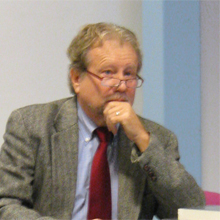
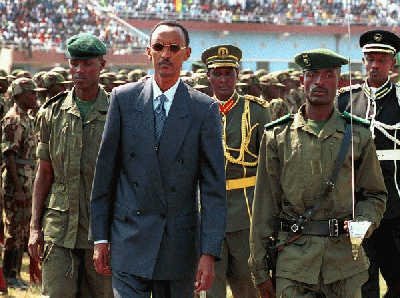
Critical: Attorney Peter Erlinder Arrested in Rwanda
Former National Lawyers Guild president, Professor Peter Erlinder was arrested last week by Rwandan Police for allegedly denying the country’s 1994 genocide. He had traveled to Rwanda from Brussels on Sunday May 23, to join the defense team of Rwandan presidential candidate Victoire Ingabire Umuhoza. He had recently attended a defense conference that they’d organized for the people working with the International Criminal Tribunal for Rwanda. He arrived in Rwanda with the intention of defending aspiring presidential candidate Victoire Ingabire and joining her legal team. Ingabire is the opposition candidate who was recently arrested and accused of denying the Rwanda genocide. Prosecutors say Erlinder made statements in publication that there was no genocide in Rwanda. Under a 2003 law, persons condemned for denying or grossly minimizing genocide, attempting to justify genocide or destroy evidence related to it are liable to a minimum of 10 years and a maximum of 20 in prison. Facebook Group – Free Professor Erlinder Now
Professor Erlinder is 62 a Chicago native and professor of law at the William Mitchell College of Law. He is a frequent litigator and consultant, often pro bono, in cases involving the death penalty, civil rights, claims of government and police misconduct, and criminal defense of political activists. He is also a frequent news commentator. Erlinder was president of the National Lawyers Guild from 1993-1997, and is a current board member of the NLG Foundation. He has been a defense attorney at the UN International Criminal Tribunal for Rwanda since 2003. National Lawyers Guild Page Updates
Gena Berglund:
- He’s accused of revisionism, revising history. Peter Erlinder years before found mountains of documentation at the UN about Rwanda’s history. He read them and discovered that the history of Rwanda is the history that’s told in the documents.
- He actually found that there was a civil war going on there for 4 years preceding the last 3 months when the alleged genocide took place.
- The civil war was the causation of the genocide. By doing this work, he encountered the wrath of the Rwandan government.
- He was trying to help the defense of an opposition presidential candidate Victoire Ingabire Umuhoza, who was arrested for “denying the genocide” and when Peter Erlinder arrived in Rwanda, he was arrested on the same charge.
- Rwanda President Paul Kagame has discredited presidential candidate Victoire Ingabire Umuhoza.
- We don’t know in the US, what’s really going on in Rwanda. The US is supporting Kagame’s war in the East Congo, the war is being fought over minerals and rights to minerals.
- Those minerals are used in cell phones.
- Help Peter Erlinder: Contact the US State Department and urge them to take an active role.
- Rwanda President Paul Kagame put 7 people on a list of those he would like to see assassinated, Peter Erlinder was on that list.
Sarah Erlinder:
- My Dad is back in the hospital, the Rwandan government is claiming that he attempted suicide.
- Gena Berglund said in the press conference that taking the pills was a “strategy’ for Peter to escape the poor conditions in the cell where he is being held with seven or eight other inmates and handcuffed each time he is taken out of the cell.
- No one has been able to talk with him since he was arrested. Peter is in a private hospital, a shared unit with 8 other patients. Facebook Group – Free Professor Erlinder Now
—
Guest – Attorney Gena Berglund with the Minnesota Chapter of the National Lawyers Guild and International Humanitarian Law Institute of Minnesota
Guest – Sarah Erlinder, Peter’s daughter, attorney and National Lawyers Guild member.
———-
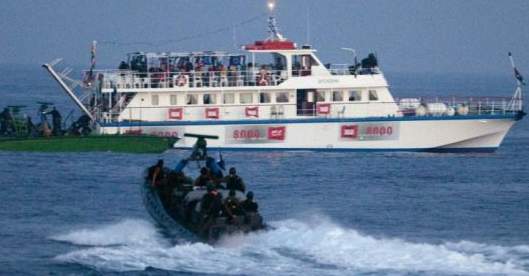
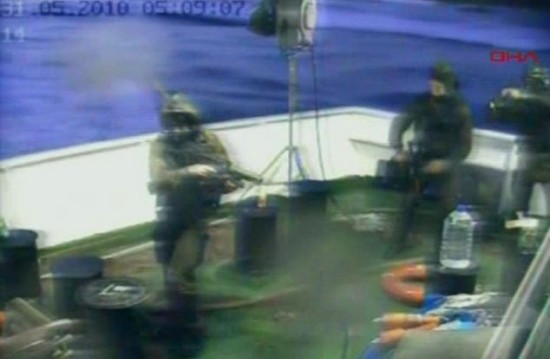
Israel Attacks on Aid Ships
International waves of protest continue over the lethal Israeli attack of 6 ships carrying humanitarian aid to the Gaza strip. The shipd called the Freedom Flotilla, were carrying shipments of wheelchairs, prefabricated homes, crayons, raw construction supplies, dental surgery equipment and reams of paper in a relief effort to end the blockade in Gaza.
The Freedom Flotilla was an effort by a coalition of human rights and humanitarian organizations to nonviolently break through Israel’s illegal blockade, and deliver much needed humanitarian and developmental aid to the Palestinians of Gaza. Almost 700 passengers from 40 different countries joined the flotilla, including: human rights workers, humanitarian aid workers, Members of Parliament, doctors, nurses, teachers, community leaders, and international journalists.
The lead coalition partners included:
- Insani Yardim Vakfi (IHH), the largest coalition partner, contributing 2 Turkish-flagged cargo ships, the Turkish-flagged passenger ship “Mavi Marmara,” and 380 Turkish nationals to the effort. This was IHH’s first attempt to break the Gaza blockade.
- The European Campaign to End the Siege on Gaza, contributing the Greek-flagged passenger ship “Sfendoni.” This was the European Campaign’s second mission to Gaza.
- The Free Gaza Movement, contributing the U.S.-flagged passenger ship “Challenger I.” This was Free Gaza’s ninth mission to Gaza.
- A Ship to Gaza, Sweden, and A Ship to Gaza, Greece, contributing the Greek-flagged cargo ship “Eleftheri Mesogeios.” This was the first voyage of A Ship to Gaza, Sweden, and the fourth of a Ship to Gaza, Greece.
Israeli Commando To Get Valor Medal / Rep. Sherman: Prosecute US Citizens Involved With Gaza Flotilla
The world watched in horror as Israeli commandos rappelled onto the ships from helicopters and opened fire. According to latest reports 19 people were killed and 60 wounded in the attack 75 miles off the coast of Israel and Gaza. The raid set off the strongest international condemnation of Israel since the 22-day military assault Operation Cast Lead in the Gaza Strip 18 months ago.
Richard Falk:
- Legality of Israel continuing the blockage against Gaza: Israel disengaged from territorial occupation in 2005 but continues to control all the borders, airspace and sea entry.
- Israel completely controls what gets in and out of Gaza, including fuel and medicines so that it’s functionally occupied and legally considered to be occupied.
- Internationally, there are several provisions requiring you to protect the necessities of the civilians
- Hamas still considered terrorist government. A blockade is an act of war
- If Gaza is defined as occupied, it is collective punishement, if it not occupied it means this is an act of war
- The UN charter is clear that any use of force that is not legally justified as self defense against an armed attack is unlawful. The law is when you’re attacked on the high seas, you have a right to act in self defense.
- The Israeli attack was a violation of the freedom of the high seas and a criminal, unlawful use of force. As far as I know, these allegations about these terrorist ties and background are completely invented, completely contrived. The New York Times has given the Israeli disinfo campaign, credibility is doesn’t deserve.
- Under customary international law, you can’t do what Israel has been doing.
- It’s a vindictive treatment of the people, the family members weren’t told if their loved ones were alive.
- The Israelis can’t claim self defense. The Israeli use of force was excessive and disproportionate.
- Israel continues to enjoy US protection and impunity.
Guest – Richard Falk professor of international law emeritus, Princeton University and Special Rapporteur on Occupied Palestinian Territories for the United Nations Human Rights Council. His book, The Great Terror War (2003), considers the American response to September 11, including its relationship to the patriotic duties of American citizens. He published Costs of War in 2008.
———————————————————————–
Afghanistan War, Civil Liberties, Gaza, Human Rights, Iraq War, Prison Industry, Targeting Muslims, Truth to Power
Podcast: Play in new window | Download
Updates:
—————-
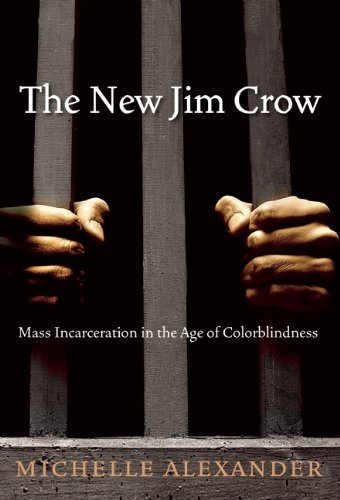

The New Jim Crow: Mass Incarceration in the Age of Colorblindness – Michelle Alexander
Michelle Alexander, author of the new book The New Jim Crow: Mass Incarceration in the Age of Colorblindness joins hosts. Michelle book has been called an incisive critique of racial caste system in America. As many celebrate the “triumph over race” with the election Barack Obama, the majority of young black men in the US are locked behind bars or permenantly labeled felons. Michelle Alexander, a former litigator who is a legal scholar, argues that the civil rights community—and all of us— are challenged to place mass incarceration at the forefront of a new movement for racial justice in America.
Michelle Alexander:
- I began in my own research to question the prevailing political media narrative about the reasons of people of color and ghetto communities cycle through the criminal justice system today, it is not as it appears.
- I argue that in a few decades after the collapse of Jim Crow, we as a nation, have managed to re-create as a racial caste in America, in some major American cities, the majority of African American men, are locked behind bars, labeled felons for life.
- Legally discriminated in employment, housing, access to education, and public benefits. We have not ended racial caste, we redesigned it.
- The Drug War was declared in relation to racial politics, not drug crime. About 30 million were arrested for drug offenses after the launch of the drug war. Most were for marijuana possession, now considered less harmful than alcohol or tobacco.
- Drug markets like American society generally are segregated by race and class
- The Supreme Court has made it virtually impossible for these cases to be brought.
- Baldus Study: McKleskey v Kemp
- Finding proof of conscious intentional discrimination is nearly impossible. Severe racial disparities are of no consequence, immunized not just the death penalty.
- I wrote this book, largely because I was deeply troubled by the failure of civil rights organizations and black leadership in this country to place mass incarceration and the war on drugs at the top of our racial justice agenda.
- Ten of millions of people in the United States are now regulated permanently to an under-caste, who are barred by law from seeking jobs or housing, public benefits, food stamps.
- Prisons have been holding many rural towns together as jobs have disappeared. The majority of people put behind bars are non-violent offenders. Every race suffers from this drug war, there are white people doing decades in prison for drug possession charges. The suffering of the drug crosses the color lines, and we got to be able to galvanize a level of public awareness and support.
- Something akin to a racial caste system is alive and well in the United States.
Guest – Professor Michelle Alexander, joined the OSU faculty in 2005. She holds a joint appointment with the Moritz College of Law and the Kirwan Institute for the Study of Race and Ethnicity. Prior to joining the OSU faculty, she was a member of the Stanford Law School faculty, where she served as Director of the Civil Rights Clinic.
Professor Alexander has significant experience in the field of civil rights advocacy and litigation. She has litigated civil rights cases in private practice as well as engaged in innovative litigation and advocacy efforts in the non-profit sector. For several years, Professor Alexander served as the Director of the Racial Justice Project for the ACLU of Northern California.
———
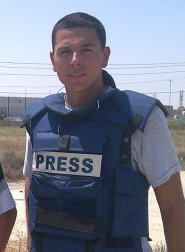
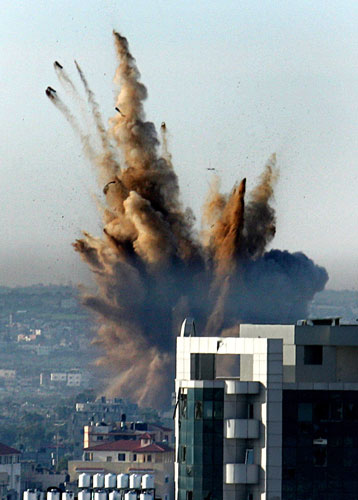

Ayman Mohyeldin, Al-Jazeera TV correspondent
Ayman joins hosts in the studio. He is an Al Jazeera TV correspondent and former CNN producer based in Baghdad. He was the only news producer allowed to observe and report on the US handover of Saddam Hussein to an Iraqi judge. Ayman has been stationed in the Gaza Strip since May 2008, where he has covered the Gaza siege. Ayman talks with hosts about his experience covering the destruction during Operation Cast Lead. Filmmakers and producers are working on a documentary film about Ayman’s war reporting in Palestine. Facebook link
Ayman Mohyeldin:
- Saturday December 27th, 2008, I had been based in Gaza. It had been quiet in Gaza up to November 4th.
- We started hearing the first wave of Israeli air-strikes that destroyed government buildings, police station within minutes. It kicked of a series of air strikes throughout the day. 200 hundred Palestinians were killed that day.
- We really saw everything, I can’t begin to describe the horrors of what we saw. On the first day we went to the main Gaza hospital.
- People of Gaza were trapped in a territory subjected to a very modern sophisticated, well trained and equipped Army.
- By Israel’s own admission rocket fire into Israel had dropped 98 percent 4 months ago (before Operation CastLead)
- What were the real reasons for the attack, the war was unnecessary given what was achieved in the 4 months prior.
- The siege on Gaza has allowed Hamas to tighten it’s grip on Gaza. The siege has not punished Hamas.
- Palestinians have recycled the rubber and steel from the destruction.
- I was standing on a rooftop and they were dropping hundreds of leaflets from planes, that read “your area is going to be attacked, if have any information about Hamas, please call this number.”
- Goldstone Report: Israel while bombing did not distinguish between military and civilian targets. Not a mistake.
- Targets include – Mosques, schools, ambulance drivers, government buildings, ministries, Palestinian Legislative Council Building.
- Gaza, historically was not an affluent place, it was a merchant trade route from Africa into Asia and Europe.
- Stunted growth is starting to appear among Palestinian children.
- Gaza: Desperate, frustrated, a sense of abandonment by the international community.
Guest- Ayman Mohyeldin, Arab American journalist based in the Middle East and is the Gaza Correspondent for the English language channel Al-Jazeera. Previously a producer with CNN and NBC, Ayman was one of the first western journalists allowed to enter and report on the handing over and trial of the deposed President of Iraq Saddam Hussein by the Iraqi Interim Government for crimes against humanity
———————-
Gaza, Human Rights, Targeting Muslims, Truth to Power
Podcast: Play in new window | Download
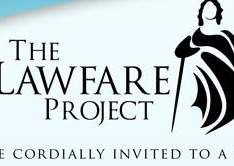
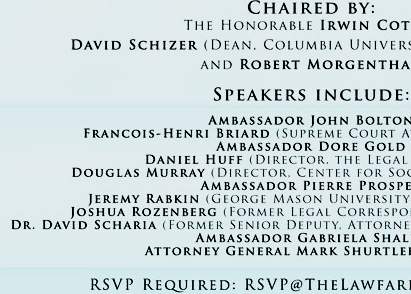
Inside the Lawfare Project: Netanyahu’s Attack on Human Rights NGO’s Hits the States
Earlier this month, the Lawfare Project, a not-for-profit organization described as dedicated to raising awareness about the abuse of the law and legal systems, held an event at the New York Lawyers Association. The project’s goals state: to facilitate a response to the perversion and misapplication of human rights law, mobilize resources and bring interested parties together in a common forum.
Max Blumenthal, award-winning journalist, was there, and reports back in his recent article, Inside the Lawfare Project: Netanyahu’s Attack on Human Rights NGO’s Hits the States. Our own Michael Ratner and the Center for Constitutional Rights was also a target. Blumenthal writes, The Center for Constitutional Rights was singled out because its founder, Michael Ratner, went on the recent Gaza Freedom March with Code Pink. None of the factual documentation these groups released was challenged by the NGO Monitor report or in Herzberg’s presentation. Instead, the groups and their leadership are being targeted with a scattershot of accusations that recall McCarthyism in its crudest form.
Max Blumenthal:
- This conference was convened at the New York Lawyers Association, with the Dean of the Columbia University Law School presiding over it.
- Politicians, neo-conservative think tank heads, and Israeli high officials, convening basically to bash the Goldstone Report which they consider to be the zenith of law fare against Israel.
- To bash the human rights groups that contributed data to the Goldstone Report.
- Law fare: Using law as a means to conduct foreign policy. Past manifestations of law fare, used by British to legitimatize laws to break up their colonies.
- Law fare Project, singled out human rights groups such as the Center for Constitutional Rights and Michael Ratner
- Israel is going further and further outside of the scope of international law. Instead of Israel having to deny charges of war crimes in a public forum they attack Judge Goldstone.
- PR firms associated with the Lawfare Project. 5wPR, which used to represent birth right of Israel. The firm is run by Ronn Torossian, who has been involved with settler attacks on Palestinians.
- They’re being funded by the law firm of Pat Robertson. The American Center for Law and Justice.
- This is I think really an effort of public diplomacy by the Israeli government funded by right wing Jewish and Christian Zionists interests.
- The NGO monitor headed by Gerald Steinberg, who is notorious in helping to de-fund, and de-legitimatize all Israel human rights groups. Israel had its first human rights march this year.
- Human rights group members in Israel, have their homes graffit’d with “price tag”, settler slang for you’ll be assassinated.
- In addition, you Michael Ratner were singled out as a traitor to the United States of America, openly and you’re in this NGO monitor black list. Put together by NGO monitor legal advisor, Ann Herzberg, you are accused of NGO lawfare. You and Human Rights Watch.
- We heard David Matas who is a Canadian lawyer, says this is equivalent to anti-Semitic gangs beating up Jews in the street, – – because International law is the legacy of the holocaust, it should always side with Israel.
- Michael Ratner: Israel wants an exemption. I’ve gone after human rights violaters in nearly every country in the world. We do a little bit of work on human rights violations in Gaza and the West Bank and all of a sudden I’m an enemy of United States, I’m anti-Semitic.
- They’re seeking emotional and subtle ethnic justification for their defense without debating the Goldstone Report.
- I think it puts Jews in danger, when they claim the Gaza assault which killed more than 700 civilians is somehow a reflection of the Jewish ethos.
- The image of it is intended to intimidate those who want to speak out, especially in the Jewish community but haven’t done so yet. We sound hopeful on this show, but this is a time for deep, deep concern.
- People are wondering, where’s the Palestinian Ghandi? My father was a White House advisor, my mother worked in the White House, my father worked in the Washington Press Corp Israel is in the grip of a mass psychosis.
- In the youth of Israel, we’re seeing a trend in favoring apartheid.
Guest – Max Blumenthal, award-winning journalist and bestselling author whose articles and video documentaries have appeared in The New York Times, The Los Angeles Times, The Daily Beast, The Nation, The Huffington Post, Salon.com, Al Jazeera English and many other publications. He is a writing fellow for the Nation Institute. His book, Republican Gomorrah: Inside The Movement That Shattered The Party, is a New York Times and Los Angeles Times bestseller.
———
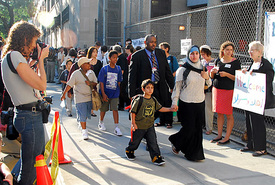
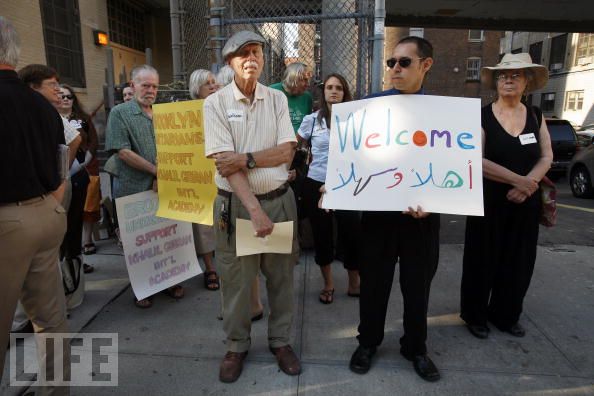
Khalil Gibran International Academy Principal Discriminated Against.
Last week the Equal Employment Opportunity Commission found that the Department of Education discriminated against interim principal Debbie Almontaser in 2007 when they forced her to resign from Khalil Gibran International Academy. The school was envisioned to provide knowledge and understanding of Arab language and culture and controversy arose before its doors opened. As we covered in November of 2007, Almontaser was forced to resign after she was quoted explaining in the New York Post that the word “intifada” literally means “shaking off” in Arabic. This was in reference to a controversy stirring over a t-shirt that read “Intifada NYC” created and worn by a group called Arab Women Active in the Arts and Media. Almontaser came under criticism by the community for not denouncing it. The EEOC ruling calls on the Department of Education to reach a “just resolution” as well as meet Almontaser’s demand, of a reinstatement, back pay, damages and legal costs. Communities In Support of KGIA
Alan Levine / Mona Eldahry:
- DOE had capitulated to mob pressure, to community prejudice, when the firestorm erupted after the New York Post article, August 2007.
- DOE, instead of quelling the fire, days went by and the fire grew. Debbie Almontaser’s qualifications were questioned, she was told if she didn’t resign the school would be closed.
- Debbie was out of central casting for the position, she couldn’t have been more perfect for it. The DOE knew about that record, that’s why they selected Debbie as principal for Khalil Gibran International Academy.
- The EEOC found that because the DOE capitulated, they became the discriminator.
- Mona : The t-shirts in question, had nothing to do with Debbie, but somehow she was associated with them. The DOE required Debbie to do this interview with the New York Post, not with the Times.
- The Post misquoted and misrepresented her as the EEOC found.
- Alan: The DOE had succumbed to the kind of prejudice that the Khalil Gibran International Academy was intended to dispel.
- The claim is based on that Debbie Almontaser was attacked by a bigoted community based on being an American Muslim and a government agency to its great shame capitulated to that prejudice.
- Certainly the DOE could have expected a strong reaction from the Arab-American community.
- Alan: The DOE investigation is accessible to us, what people said in this investigation will be part of the record in this case (federal) The EEOC is the premier agency in the country for evaluating employment discrimination claims.
Guests, attorney Alan Levine and Mona Eldahry, co-founder of Arab Women Active In the Arts.
——————————————————–
Afghanistan War, Civil Liberties, Gaza, Human Rights, Iraq Veterans, Iraq War, Targeting Muslims, Torture, Truth to Power
Podcast: Play in new window | Download
Updates:
—
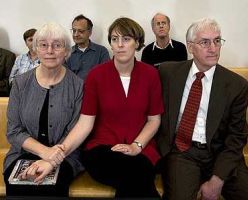
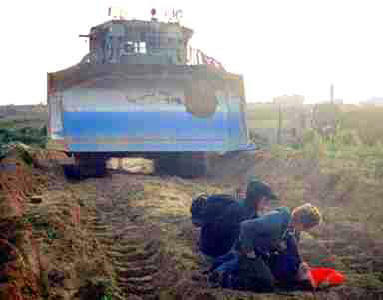
Rachel Corrie wrongful death v Israel
This month, the Haifa District Court in Israel will begin hearing eyewitness testimonies in a civil lawsuit filed in 2005 by Rachel Corrie’s family against the State of Israel for her unlawful killing in Rafah, Gaza. On March 16, 2003, Rachel was crushed to death by a Caterpillar D9R bulldozer while trying to protect the home of a Palestinian doctor from demolition. She was run over and killed by an IDF soldier who was operating the bulldozer. Seven years later, Rachel’s parents are still seeking the truth. The trial is expected to show the circumstances of her death and hold the Israeli military reponsible. Four eyewitnesses to Rachel’s killing have been recently granted visas by Israel to testify but Israel is refusing to allow the Palestinian doctor who treated Rachel and confirmed her death into Israel.
Maria LaHood:
- CCR represented Rachel Corrie in the United States because she was run over by a Caterpillar bulldozer. The same month in 2005, the Corries brought a suit against Israel, in Israel for the killing.
- This suit was on the advice of the US State Department. You can sue Israel, the country. Israel claims immunity.
- Israel’s defense that the bulldozer driver couldn’t see Rachel Corrie in the bright orange jacket.
- Expert witness says Israel’s heavy machinery operator policy says do not use around people.
- Rachel was defending the home and the bulldozer crushed her. Rachel was with the International Solidarity Movement. The Corrie family will present their evidence to the Israeli court and then there’s a 30 day break in the trial. This is not a jury trial, it is before a judge. Corries are asking for information, and accountability.
- In the attacks of Gaza a year ago, more than 4000 houses were demolished.
- Someone was filming at the border at the time of Rachel’s death, the actual part of the tape where she was crushed is missing.
- Mamilla Cemetery Case Update: We’ve asked the special rapporteurs of the United Nations to intervene.
- Michael Ratner: It does seem to be intentionally provocative. To be doing this on a cemetery and calling it the “Center for Tolerance” MamillaCampaign website.
Guest – Staff attorney Maria LaHood. Maria specializes in international human rights litigation, seeking to hold government officials and corporations accountable for torture, extrajudicial killings, and war crimes abroad. Her cases include Arar v. Ashcroft, against U.S. officials for sending Canadian citizen Maher Arar to Syria where he was tortured and detained for a year; Matar v. Dichter, against an Israeli official responsible for a “targeted assassination” that killed 15 Palestinians; Belhas v. Ya’alon, against a former Israeli official responsible for the 1996 shelling of a United Nations compound in Qana, Lebanon, that killed over 100 civilians; Corrie v. Caterpillar, on behalf of Palestinians killed and injured in home demolitions, and Rachel Corrie, a U.S. human rights defender who was killed trying to protect a home from being demolished.
———–
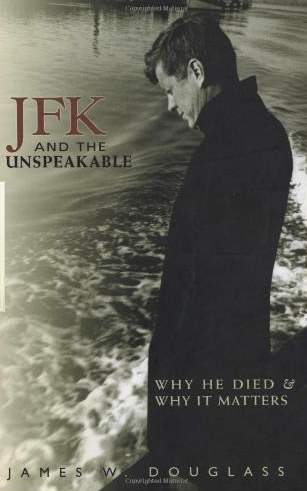
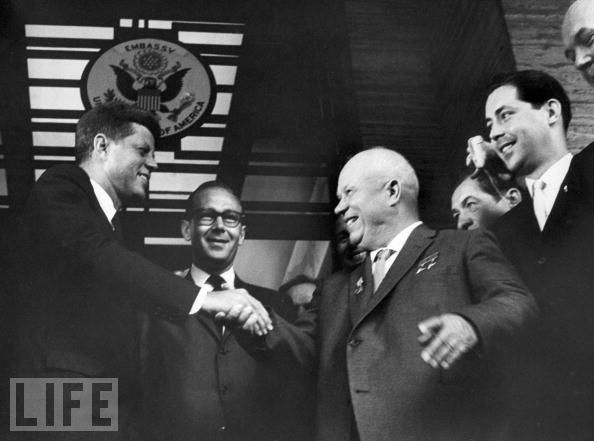
JFK and the Unspeakable: Why He Died and Why It Matters by Jim Douglass
JFK, The Unspeakable, is the first book of 3 on the assassinations of the 1960s. Orbis Books has commissioned author James W. Douglass to write about the murders of JFK, Malcolm X and Martin Luther King, and his the third will be on the assassination of Bobby Kennedy. The heart of JFK the Unthinkable, is not how Kennedy was killed or how Kennedy became a threat to the systemic war machine, but why DID Kennedy die? Author James Douglass says Kennedy knew that he would die and had the guts to stand up to the system and take the hit. This narrative was lost for decades, obscured by disinformation about Kennedy’s character and the conspiracy of his assassination. One review summarizes Douglass’s book in this way : JFK’s belated effort to turn America from an armed culture of victory to a member of an international peaceful world was shot down in Texas for a reason.
Jim Douglass:
- John F. Kennedy’s experience in WWII: He was in the South Pacific, he volunteered. He was on that PT boat.
- What happened on that PT boat, is that it got split into two by a Japanese destroyer. He lost brothers and friends at that time. An extraordinary experience being adrift on the ocean warning other PT boats. The experience create a distrust in military authority.
- He said that he wanted to splinter the CIA into a thousand pieces and scatter to the winds.
- As Kennedy said to his friends, “they figured me all wrong.”
- The Unspeakable: the kind of evil and deceit that seems to go beyond the capacity of words to describe. The midst of war and nuclear arms race, the assassinations of Kennedy, Martin Luther King and Malcom X that the term was used.
- JFK’s vision is articulated in the address June 10, 1963, arising from the turnaround of the missile crisis and Bay of Pigs.
- He wanted to move step by step into a disarmed world. Nikita Khrushchev put that speech all over the Soviet Union. The Cuban Missile Crisis is a deeply misunderstood part of our history, because it’s usually portrayed as Kennedy going to war with Nikita Khrushchev and beating him.
- The truth was that Kennedy and Nikita Khrushchev were in over their heads, the US generals wanted nuclear war, because they had more warheads than the Soviets.
- Nikita Khrushchev: We now have a common enemy from those pushing us toward war.
- At that point the Cold War turned upside down because Kennedy and Khruschev became closer to each other than either was toward their own military power system.
- Vietnam: Kennedy’s military people would not give him an exit policy. He signed the withdrawal order from Vietnam before he was assassinated.
- His friends said that he had an obsession with death. It was not an obsession but a real assessment that he was going to die. If you try to turn around a national security state that is dominating the world,
- and you do so as president of the United States, of course you’re going to die. Kennedy knew that.
- The book is a story on the deliberate destruction of hope, the vision of change, a turning of this country all of which was happening and had to be stopped. US Agencies killed Dr. Martin Luther King – 1999 Verdict
- We’re in the same scene right now with Petraeus and McChrystal setting up Obama. They were dictating terms to Obama, unlike Kennedy, he did not face them down.
- We need to get out ahead of Obama so that he can do something.
Guest -author, James W. Douglass. He’s a longtime peace activist and writer. James and his wife Shelley are co-founders of the Ground Zero Center for Nonviolent Action in Poulsbo, Washington, and Mary’s House, a Catholic Worker house of hospitality in Birmingham, Alabama.
—————————
Civil Liberties, Criminalizing Dissent, Gaza, Human Rights, Prosecution of the Bush Administration, Supreme Court, Surveillance, Targeting Muslims, Torture
Podcast: Play in new window | Download
Updates:
—
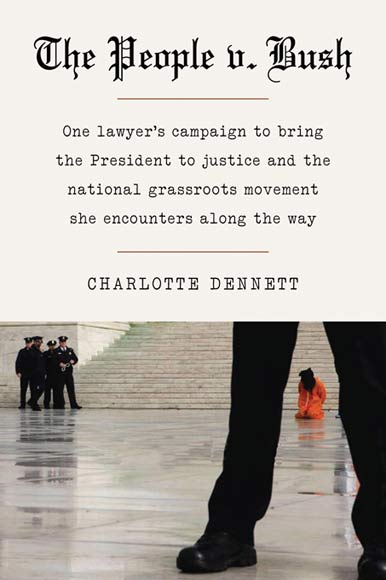
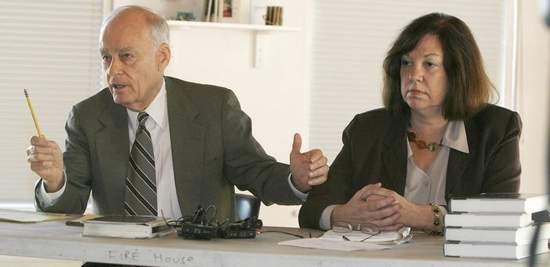
People v Bush, Charlotte Dennett
Today we talk with former Vermont Attorney General Candidate Charlotte Dennett. Listeners may remember Charlotte ran for office of Attorney General on the platform that if elected she would immediately undertake the prosecution of George W. Bush for the unnecessary deaths of Vermont soldiers in Iraq. The strategy was to establish jurisdiction in the cases for Attorneys General in each state as outlined in The Prosecution of George W. Bush for Murder, written by former prosecutor Vincent Bugliosi. Charlotte Dennett didn’t get the votes to become Vermont’s new attorney general. Now, a year later Charlotte describes from an inside perspective the “accountability movement” in her new book titled The People v. Bush. Is impeachment or prosecution still off the table?
Charlotte Dennett:
- If we don’t act on them now, then the impunity will get worse, we have to clamour for Cheney’s prosecution. We’ve got to keep the pressure on the department of justice. We know that the Spanish prosecutors have done that.
- I’ve come to realize that Obama’s mantra that we have to move forward and not look backward is really translated into: Don’t Prosecute.
- Brennan who was involved with crafting torture policy is playing a role advising Obama not to prosecute.
- It’s up to the accountability movement to step forward. There are going to be major events on March 20th, the anniversary of the war on Iraq.
- In my book the People v. Bush, I’ve got 10 pages in the appendix of all the different resources that people can turn to, to pressure Congress, sign petitions.
- The first half of the book is about my campaign for attorney general in Vermont, where I pledged to prosecute Bush for murder. I also lay out the evidence of how we can still do this, we can still do this by the way.
- I became hooked on accountability, this is a struggle for democracy and the soul of our nation.
- The book also looks at how the Obama Administration deals with the crimes of its predecessors.
- I have to tell you Michael Ratner, you were one of the first people to start raising the alarms (Obama Administration). My book shows the gradual shock and disillusionment of his supporters.
- People are upset that John Yoo, is doing talk shows, he showed up on John Stewart recently (OUCH)
- Regarding Sen. Leahy of Vermont: I tracked his effort to put together a truth commission and not prosecution. There were 37 towns in Vermont, that in their town meetings, voted for impeachment.
Guest – Charlotte Dennett, is an author and attorney who resides in Cambridge Vermont. She and her husband, Gerard Colby, have lived in Vermont since 1984. Charlotte has been practicing law since 1997, representing injured Vermonters in negligence, medical malpractice and wrongful death cases, as well as civil rights litigation and family law, and has argued before the Vermont Supreme Court.
——-

Lawyers You’ll Like: Center For Constitutional Rights Legal Director, Bill Quiqley
This week, CCR Legal Director Bill Quigley joined Law and Disorder hosts during a marathon 3 hour fund raiser for Pacifica’s WBAI. Bill talked about his trip to Gaza during Operation Cast Lead, his recent trip to Haiti and his death penalty work in Louisiana.
Bill Quigley:
- I went to Gaza with activist Audrey Stewart and Kathy Kelly, an International Peace Activist.
- We went over there, a year ago January, while the bombing was still going on. We were on the Egyptian side of the border where we could see the bombing of Gaza
- There were constant drones going over head, they had aerial balloons that were doing surveillance. It was sort of like a sociopath beating a baby. There was no defense, there was no anti-aircraft, people were literally sitting ducks.
- In my life, it compared to a time when one of my clients was being executed, in death row in Louisiana. To see the apparatus of the state, move into action, very calm, step by step.
- Then with full force and the respect of state behind it, pull on a switch and my client was no more. (at that time) It was a surprise that anyone in the U.S. would support the Palestinians.
- Death Penalty: there really is a community of deathy penalty advocates who train themselves how to communicate with juries. It is trending in the right direction by it still continues as a terrible tool, that the state has an opportunity to use when they choose to.
- Stop and frisk case update: New York is fighting this every step of the way. The term they use to justify this is: Furtive activity
- Culture of Intimidation: If young men don’t look at them the way they want to be looked at, if people don’t recognize their presence with the kind of respect that the police department thinks that they’re entitled to by the mere fact that they’re wearing a uniform and carrying a weapon.
- It is something that clearly could stop if the message was sent from the top.
- But clearly something has a green light from the top to engage in this. Authoritarian order that inconsistent with law and order, with the constitution.
- Endemic: If you have a society that values violence, the violence we institute around the world, the way we support Israel, the way they deal with Palestine. If we value deep racism, then what else what would we expect from a police or a military. The police and military are tools of a violent and racist regime.
- Part of our job is to re-educate police officers. We are going to be engaged in this activity over again, in every city in the country in varying degrees. The root problem is that we have a racist and violent criminal justice system, education system, a racist and marginalizing housing system, employment system.
- Most people don’t have the educational opportunities to know what’s going on with Haiti, Gaza, Iraq and even within our own country. Haiti: You could travel for miles and see no indication that international community even cared about what happened in Haiti. Most people were under a sheet or a blanket, could break some of the sun.
Guest – Bill Quigley. Bill is the Legal Director for the Center for Constitutional Rights, a national legal and educational organization dedicated to advancing and defending the rights guaranteed by the United States Constitution and the Universal Declaration of Human Rights. Bill joined CCR on sabbatical from his position as law professor and Director of the Law Clinic and the Gillis Long Poverty Law Center at Loyola University New Orleans. He has been an active public interest lawyer since 1977.
———————————————-
Civil Liberties, Criminalizing Dissent, FBI Intrusion, Gaza, Human Rights, Prison Industry, Truth to Power
Podcast: Play in new window | Download
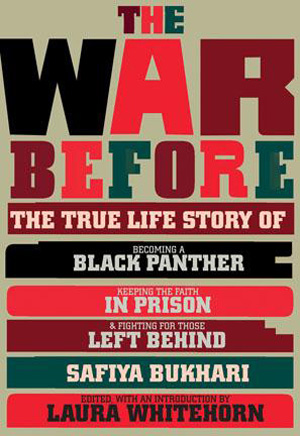
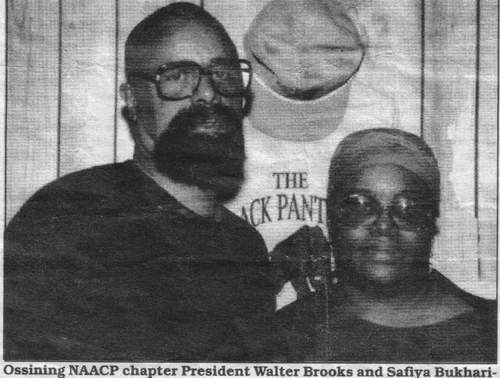
The War Before: The Story of Black Panther and Political Prisoner Safiya Bukhari – By Laura Whitehorn
We’re delighted to have political activist and former Weather Underground member Laura Whitehorn back with us to talk about her new book titled, The War Before. In the book about Laura introduces us to Safiya Bukhari, a member of the Black Panther Party in the late 1960s. The War Before traces Safiya’s life’s commitment of organizing around the rights of the oppressed. Through Safiya’s personal writings, we hear her unique perspective of what had happened to the Black Panther Party and her personal insights into the incarceration of outspoken radicals. Safiya, herself a longtime political prisoner and jailhouse activist, died in 2003. It was at the request of Safiya’s daughter Wonda Jones, that Laura assembled and edited the War Before.
Laura Whitehorn/Sundiata Sadiq:
- When I was first in prison there was no library. Nothing. Whoever we were as political prisoners, we would have met Safiya. When she got out of prison in 1983, she made it her business to go and fight for every political prisoner in this country, that she could get to who wanted to be part of a movement to free political prisoners.
- Safiya: The fight for the freedom of political prisoners can’t be separate from the fight against repression in general whomever that is effecting. If she were alive today, I’m sure she would have been at the rally for Fahad Hashmi and fighting for the rights of immigrant detainees.
- Safiya: Political prisoners will continue to arise if people oppose the government.
- This book began with Wonda Jones (Safiya’s daughter) Wonda in some ways has been working on this book for her entire life.
- Safiya was aware all the time that the “freedom and democracy” that this country promotes as its image only exists on the suffering of so many people. Her politics were a challenge to the government all along, her being was a challenge.
- Some of these are essays, some of these are speeches. Safiya was investigating, she was questioning, she was willing to look at herself, what each of us brings into a movement. There is a connection between her humility, her honesty and her commitment.
- Sundiata: I became close to Herman Ferguson and Safiya.
- Laura: I was in prison when Jericho was founded.
- Sundiata: I was asked to get Sofiya into the Sing Sing Prison to talk to the brothers.
- They had to remove her (Safiya) uterus because of fibroids.
- In the February issue of the Monthly Review we have an excerpt of Sofiya’s chapters. It’s about post traumatic stress symptoms in the Black Panther party. When I was putting this manuscript together and re-read it, I thought, I would like people to read this book from beginning to end.
Guest: Laura Whitehorn – revolutionary ex-political prisoner and native New Yorker Laura Whitehorn. Since the 1960s Laura was active in supporting groups such as the Black Panther Party, the Black Liberation Movement and was active with Students for a Democratic Society and the Weather Underground. Laura also worked to expose the FBI’s Counter Intelligence.
Guest – Sundiata Sadiq. (Walter Brooks) He is a leading member of the Free Mumia Abu-Jamal Coalition in New York City and was a close friend of Safiya Bukhari for many years. Sudiata has been politically active since the late sixties, and he was also the president of the Ossining, New York Chapter of the NAACP.
—-
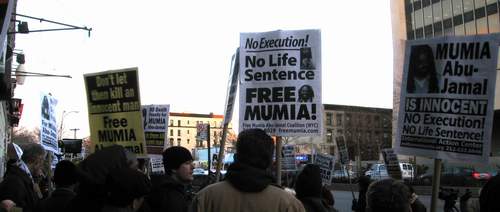
Educators for Mumia Abu-Jamal: Johanna Fernandez
The U.S. Supreme Court recently re-opened the possibility that Pennsylvania may execute award-winning journalist and world-renowned “Voice of the Voiceless” Mumia Abu-Jamal. The high Court referred his case back to the Third Circuit to reconsider its 2008 decision that Mumia could have a new penalty phase hearing in light of the Court’s ruling in the Ohio case of Smith v. Spisak. Spisak’s jury-imposed death sentence had been reversed when his attorneys, like Mumia’s, successfully invoked a critical 1988 Supreme Court decision in the Mills V. Maryland case. Mills rejected the idea that jurors had to be unanimous on the mitigating circumstances that existed in a case. Before Mills, juries had little or no alternative but to impose death if even one juror blocked consideration of a mitigating circumstance. The High Court’s recent decision in Mills will now make it easier to obtain death sentences in capital cases; Mumia’s attorneys will argue that his case is distinguishable from Spisak’s.
Mumia as many know, was convicted and sentenced to death for the 1981 murder of police officer Daniel Faulkner. A previous guest here on Law and Disorder, author/ journalist J. Patrick O’Connor who wrote The Framing of Mumia Abu Jamal, says the real shooter was Kenneth Freeman a business partner of Mumia’s brother. Freeman, was found dead in 1985, bound and cuffed in a Philadelphia parking lot.
Professor Johanna Fernandez:
- Educators for Mumia Abu-Jamal emerged in the 1990s to build a profile for Mumia on college campuses among educators and students.
- We’re also making the movement mainstream in pointing out what’s wrong with the criminal justice system.
- We’re getting a hip hop show for schools for spring break (Pennsylvania colleges)
- We want to educate young people and students in a nation that incarcerates 3 million people. That’s the size of San Francisco.
- I’ve known Mumia for about five years. I have used Mumia in the classroom live through phone conference. He speaks on issues such as the Vietnam War, the civil rights movement, the Black Panther Party and the criminal justice system today. These live conferences are incredibly powerful.
- Conversations with Mumia are intense, we talk about politics, Obama. We talk a lot about what life is like on death row. His cell is the size of a small bathroom. He’s only allowed 20 books at any given time. His cell is messy because he’s a researcher, a writer.
- Mumia: food is horrendous. They’re allowed to buy food, MRE style pre-packaged dry food. The servicing of inmates in this country is a billion dollar industry.
- What’s interesting about his situation is the state has tried to strip him of his intellectual vitality. Although they have failed, he’s written six books from death row, he’s got his radio journals.
- The first thing the movement is asking people to do is to arm themselves with the facts of the case. Then you can sign a petition. There’s another petition calling for Obama to make a statement on the case.
- If you’re a student or a university professor we are asking you to help us organize a large town hall meeting, for April 3, 2010 (likely in NYC) Mumia’s case should be taken up during Black History Month by colleges all over the city.
Guest – Educators for Mumia member Johanna Fernandez. Johanna Fernandez is a native New Yorker. She received a Ph.D. in History from Columbia University and a B.A. in Literature and American Civilization from Brown University.
——-
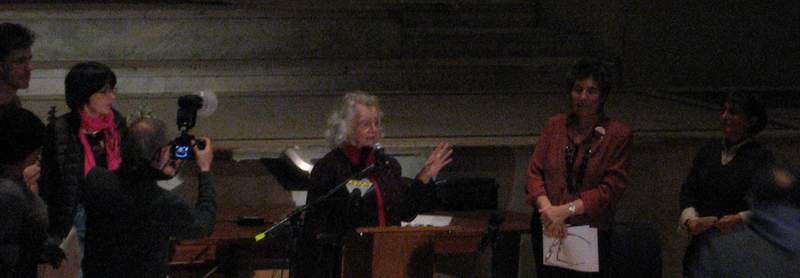
Gaza Freedom March Report Back Speeches
We hear another strong speech from Palestinian teacher and filmmaker Fida Qishta. Fida is from Rafah, Southern Gaza.
Gaza Freedom March Commitments Include:
- Palestinian Self-Determination
- Ending the Occupation
- Equal Rights for All within historic Palestine
- The full Right of Return for Palestinian refugees
From: Waging Nonviolence blog. The Egyptian government didn’t let most of the over 1,300 protesters from around the world into Gaza for the planned march, but those at Judson said that they witnessed a new stage in the emergence of a global movement, facilitated by the Internet, that may well be poised to end the international support that makes Israel’s policies possible. The lynchpin of the movement, the Cairo Declaration of the Gaza Freedom March, was drafted by would-be marchers while they waited in Egypt.
——————————————————————————————–













